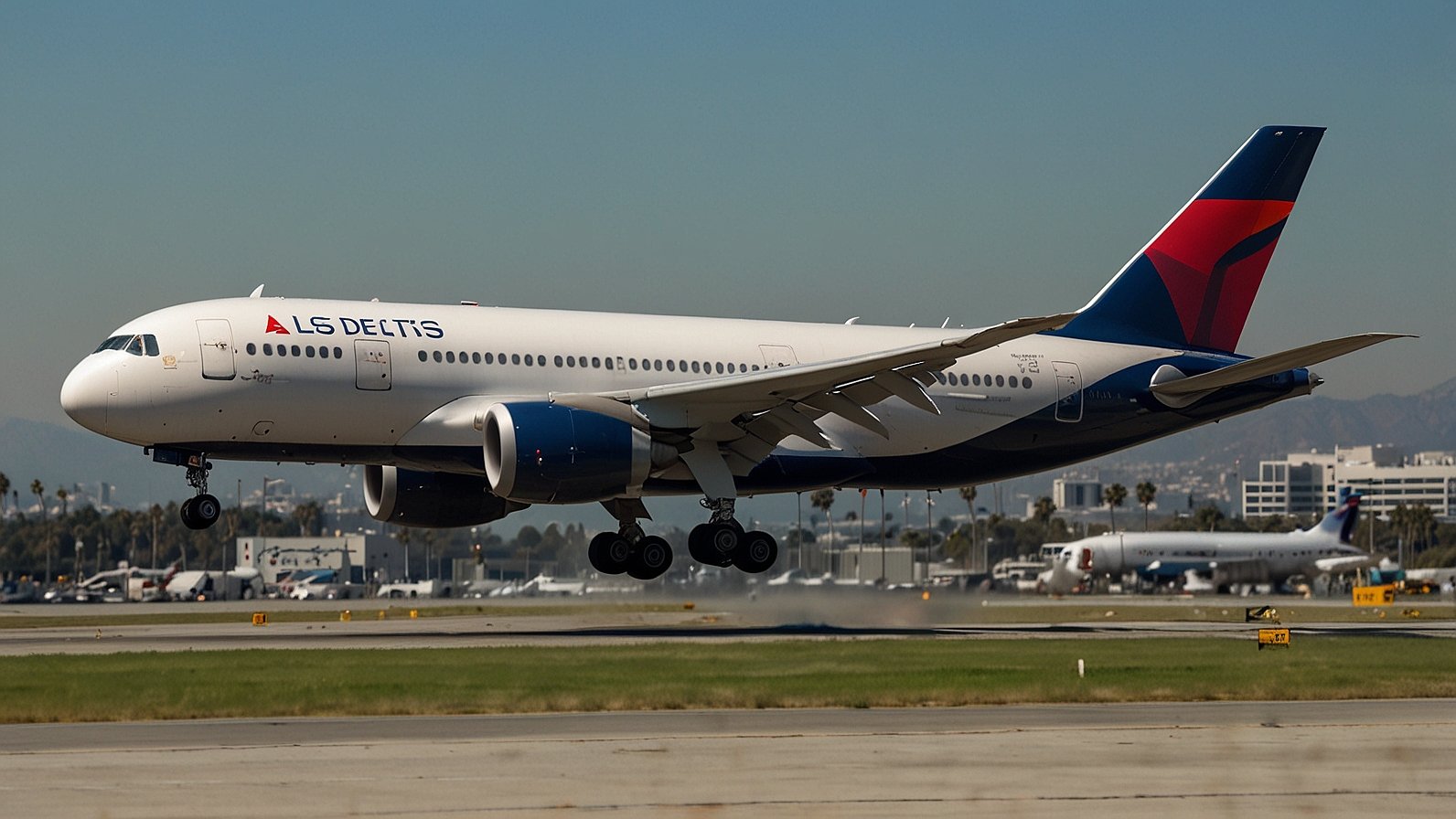Ever been cruising along on a road trip, tunes playing, when suddenly a warning light flashes on the dashboard? That little jolt of “uh-oh,” the immediate shift from autopilot to focused attention – that’s likely a fraction of what the crew and passengers of Delta Flight DL275 diverted LAX experienced on August 12th, 2025. What started as a routine journey from Detroit to Tokyo’s Haneda Airport took an unexpected turn high above the Pacific Ocean. Let’s unpack what happened, why it matters, and why this story is actually a testament to aviation safety working exactly as it should.
The Moment Things Changed: DL275’s Mid-Pacific Pivot
Delta Air Lines Flight DL275 is a vital transpacific link, typically operated by one of Delta’s modern workhorses, the Airbus A350-900. On this Tuesday, the aircraft pushed back from Detroit Metropolitan Wayne County Airport (DTW), lifted off, and settled into its long trek across the ocean towards Tokyo Haneda (HND).
Everything seemed routine until, cruising at high altitude, the flight crew encountered an unexpected issue. Reports indicate a technical problem arose, specifically related to the aircraft’s engine anti-ice system. Think of this system like your car’s defroster on steroids – it’s absolutely critical for preventing ice buildup on the engine inlets during specific cold, moist conditions at altitude. Ice ingestion into a jet engine can be catastrophic.
Faced with this situation, the pilots didn’t hesitate. Following strict procedures and prioritizing safety above all else – including schedules and fuel costs – they made the decisive call: a diversion was necessary. Scanning their options, Los Angeles International Airport (LAX) emerged as the clear best choice.
- Proximity: LAX was the closest major international airport capable of handling an A350 with full support services.
- Capability: LAX has extensive maintenance facilities, Delta operations, and the long runways needed for a safe landing with potentially complex follow-up checks.
- Safety Margin: Choosing LAX ensured the aircraft could land well within its operational and fuel limits, eliminating undue pressure.
The pilots expertly guided the A350 down to a safe landing at LAX. Crucially, no injuries were reported among the passengers or crew. While undoubtedly an inconvenience for those heading to Tokyo, the paramount outcome – a safe landing – was achieved.
Why LAX? Understanding Diversion Decisions
It might seem surprising that a flight bound for Tokyo would land in Los Angeles. Why not turn back to Detroit or head to Anchorage? Diversion decisions are complex and made rapidly, balancing multiple critical factors:
- Immediate Safety: Is the aircraft safe to continue flying right now? If the answer is uncertain or “no,” diversion is immediate.
- Proximity & Time: What’s the closest suitable airport? Every minute counts in an abnormal situation.
- Airport Suitability:
- Runway Length: Can the runway handle the aircraft’s weight and landing speed?
- Facilities: Are maintenance crews, stairs, gates, and passenger handling available?
- Customs/Immigration: For international flights, does the airport have facilities to process passengers?
- Airline Presence: Does the operating airline (Delta, in this case) have a base or significant operations there for support?
- Weather Conditions: What’s the weather like at potential diversion points?
- Passenger & Crew Needs: Availability of medical support if needed, and facilities to handle passengers during delays.
LAX ticked all these boxes for DL275. It was the optimal “safe harbor” given their position and the nature of the technical issue.
Inside the Anti-Ice System: Why It’s So Crucial
So, what’s the big deal about an engine anti-ice system? Jet engines suck in massive amounts of air. If that air is very cold and moist (common at cruising altitudes), ice can form on the engine inlet lip or fan blades. This is bad news for several reasons:
- Disrupted Airflow: Ice changes the smooth flow of air into the engine, causing turbulence and inefficiency.
- Potential Engine Damage: Large chunks of ice breaking off can be ingested, potentially damaging compressor blades.
- Loss of Power: Severe ice buildup can significantly reduce engine thrust or even cause a flameout (the engine stops running).
How it Works (Simplified): Hot air is “bled” off from the engine’s compressor section (after it’s been compressed and heated). This very hot air is then ducted through passages in the engine inlet lip, warming the surface and preventing ice from forming. Think of it like constantly running a hairdryer over the engine’s “mouth” in icy conditions. A fault in this system means that protective heat might not be reliably available when needed.
The Safety Net: Modern aircraft like the A350 have incredibly sophisticated monitoring systems. They constantly check the health of critical components like anti-ice. When a potential problem is detected, it triggers alerts in the cockpit, giving pilots ample information and time to assess and act, as the DL275 crew did.
Beyond DL275: How Diversions Keep Flying Safe
While the Delta Flight DL275 diverted LAX incident made headlines because of the major airports involved, diversions are a routine part of aviation safety. They happen more often than most passengers realize, usually for less dramatic reasons:
- Medical Emergencies: A passenger or crew member falls seriously ill.
- Minor Technical Snags: A sensor fault, a cabin pressure irregularity, or an indicator light malfunction – if it can’t be resolved confidently in flight, diversion is the prudent choice.
- Weather Enroute or at Destination: Unexpected severe turbulence, storms developing over the planned route, or sudden fog closing the destination airport.
- Security Concerns: Very rare, but potential threats are taken extremely seriously.
The “Safety First” Culture: The decision to divert, especially on a long-haul flight, is never taken lightly. It involves significant cost, logistical headaches, and passenger disruption. However, airlines and pilots operate under a fundamental, non-negotiable principle: safety is paramount. There is absolutely no pressure on crews to “push on” with a potential problem. Regulations and airline culture strongly support the “when in doubt, land” philosophy. The DL275 diversion exemplifies this culture perfectly.
What Happened Next for DL275 Passengers?
Landing safely at LAX was step one. Then came the operational challenge for Delta:
- Deplaning: Passengers safely disembarked.
- Assessment: Delta maintenance teams thoroughly inspected the A350 to diagnose the exact nature of the anti-ice system issue.
- Passenger Care: Delta’s customer service teams swung into action:
- Providing meals and refreshments.
- Arranging hotel accommodations for the unexpected overnight stay.
- Working to rebook passengers onto alternative flights to Tokyo (HND), either on later flights from LAX or via other Delta hubs. This process takes time, especially for a full A350 load (typically 300+ passengers).
- Handling luggage logistics.
- Aircraft Repair: Once diagnosed, repairs were undertaken. If parts were needed, they would be sourced. Only after rigorous testing and sign-off would the aircraft be cleared to return to service.
Passengers faced significant delays – likely 24 hours or more – to reach their final destination. While frustrating, this is the necessary consequence of prioritizing the safe resolution of the technical problem.
3 Key Takeaways from the DL275 Diversion
- Aviation Safety Systems Work: This incident wasn’t a failure; it was the system succeeding. The problem was detected, the crew followed procedures flawlessly, a safe diversion point was chosen, and the landing was uneventful. That’s textbook safety management.
- Diversions are Safety Features, Not Failures: Think of a diversion like an airbag deploying in your car. It’s an inconvenience, maybe even scary in the moment, but it’s a designed safety response that did its job. The crew’s decision was proactive and correct.
- Modern Aircraft are Incredibly Resilient: The Airbus A350 is packed with redundancies and sophisticated monitoring. While complex systems can develop faults, the design incorporates multiple layers of safety. The anti-ice system fault was managed effectively because of the aircraft’s design and crew training.
Your Flight & Peace of Mind: What This Means For You
Knowing about incidents like the Delta Flight DL275 diverted LAX shouldn’t make you nervous about flying; it should offer reassurance. Here’s why:
- Hyper-Vigilant Monitoring: Your flight is constantly being monitored by both the crew onboard and sophisticated systems on the ground.
- Pilot Expertise: Pilots undergo relentless training for exactly these kinds of scenarios. Their primary job is safe operation, not sticking to a schedule.
- Built-in Redundancy: Critical systems like engines, hydraulics, and flight controls have backups upon backups.
- Safety Culture is King: From mechanics to dispatchers to flight attendants, everyone in aviation is empowered and expected to speak up about safety concerns.
Flying remains one of the safest modes of transport globally, precisely because of how seriously events like diversions are taken.
Have You Experienced a Diversion?
While the Delta Flight DL275 diverted LAX story had a safe resolution, it highlights the unpredictable nature of air travel. Diversions, big or small, are part of the safety fabric. Have you ever been on a flight that diverted? What was the reason, and how did the airline handle it? Share your experiences or thoughts on aviation safety in the comments below – let’s discuss!
You May Also Read: $8 Million Yacht Capsizes Near Annapolis: Rescue, Recovery & the Open Door That Sank a Superyacht
FAQs
Q: What exactly happened to Delta Flight DL275?
A: Delta Flight DL275, an Airbus A350 flying from Detroit (DTW) to Tokyo (HND), diverted to Los Angeles (LAX) on August 12, 2025, due to a reported technical problem with the aircraft’s engine anti-ice system. It was a precautionary safety measure.
Q: Was the Delta DL275 diversion dangerous?
A: No, the diversion itself was a controlled safety procedure. The crew identified a potential issue, followed protocols, and landed the aircraft safely at LAX without incident or injuries. It demonstrates the system working correctly.
Q: Why did they choose to divert to LAX instead of turning back or going elsewhere?
A: LAX was the closest major international airport with the necessary long runways, full maintenance facilities, Delta operational support, and customs capabilities to safely handle the A350 and its passengers given their location over the Pacific.
Q: How common are flight diversions like this?
A: Diversions for technical issues, medical emergencies, or weather are more common than most passengers realize, though often to less prominent airports. They are a standard part of aviation safety protocols to manage risks proactively.
Q: What happened to the passengers after landing at LAX?
A: Delta provided care including meals, accommodations, and worked to rebook all passengers onto alternative flights to Tokyo. This process caused significant delays but ensured their eventual safe arrival.
Q: What is an engine anti-ice system, and why is it so important?
A: It prevents ice buildup on the engine inlet by bleeding hot air from the engine to warm the surface. Ice can disrupt airflow, damage the engine, or cause power loss, making the system critical for safe operation in cold, moist conditions at high altitude.
Q: Was the Delta A350 damaged?
A: Based on reports, the aircraft landed safely without incident. The diversion was prompted by a system fault indication, not necessarily confirmed physical damage. It underwent inspection and repair at LAX before returning to service.










